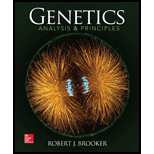
Concept explainers
The terms conjugation, transduction, and transformation are used to describe three different natural forms of genetic transfer between bacterial cells. Briefly discuss the similarities and differences among these processes.
To review:
The similarities and differences among transformation, conjugation and transduction.
Introduction:
Genetic recombination is characterized by DNA (deoxyribonucleic acid) transfer in bacteria, from one organism, known as the donor, to another organism, known as the recipient. Such a genetic transfer is also known as horizontal gene transfer. In bacteria, obligate sexual reproduction is not present. Horizontal gene transfer is also known to occur between different species.
Explanation of Solution
The differences between transformation, conjugation and transduction are tabulated below.
| Transduction | Transformation | Conjugation |
| The transfer of the genes from one bacterium to another is referred to as transduction. | The incorporation of exogenous genetic material, resulting in the genetic alteration of a cell, is called transformation. | The genetic material transfer among the bacterial species with the help of sex pilus is called conjugation. |
| It does not require for the occurrence of any physical contact between the recipient and the donor organism. | It requires the occurrence of physical contact between the recipient and the donor organism. | There is a direct cell-to-cell contact or a bridge-like connection between the two cells. |
| Resistant to DNase. |
Not resistant to DNase. | Role of DNase is not defined. |
The similarities among transformation, conjugation and transduction are as follows:
1. All three, that is, transformation, transduction and conjugation, are examples of horizontal gene transfer as genetic information is not transferred from the parent to the offspring.
2. All three methodsincrease genetic variation as a part of genetic material is transferred from the donor to the recipient.
Therefore, it can be concluded that all three, that is, transformation, transduction and conjugation are methods of transferring genetic material, but they all differ in the process of transfer.
Want to see more full solutions like this?
Chapter 7 Solutions
Genetics: Analysis and Principles
- please fill in the empty sports, thank you!arrow_forwardIn one paragraph show how atoms and they're structure are related to the structure of dna and proteins. Talk about what atoms are. what they're made of, why chemical bonding is important to DNA?arrow_forwardWhat are the structure and properties of atoms and chemical bonds (especially how they relate to DNA and proteins).arrow_forward
- The Sentinel Cell: Nature’s Answer to Cancer?arrow_forwardMolecular Biology Question You are working to characterize a novel protein in mice. Analysis shows that high levels of the primary transcript that codes for this protein are found in tissue from the brain, muscle, liver, and pancreas. However, an antibody that recognizes the C-terminal portion of the protein indicates that the protein is present in brain, muscle, and liver, but not in the pancreas. What is the most likely explanation for this result?arrow_forwardMolecular Biology Explain/discuss how “slow stop” and “quick/fast stop” mutants wereused to identify different protein involved in DNA replication in E. coli.arrow_forward
- Molecular Biology Question A gene that codes for a protein was removed from a eukaryotic cell and inserted into a prokaryotic cell. Although the gene was successfully transcribed and translated, it produced a different protein than it produced in the eukaryotic cell. What is the most likely explanation?arrow_forwardMolecular Biology LIST three characteristics of origins of replicationarrow_forwardMolecular Biology Question Please help. Thank you For E coli DNA polymerase III, give the structure and function of the b-clamp sub-complex. Describe how the structure of this sub-complex is important for it’s function.arrow_forward
 Biology: The Dynamic Science (MindTap Course List)BiologyISBN:9781305389892Author:Peter J. Russell, Paul E. Hertz, Beverly McMillanPublisher:Cengage Learning
Biology: The Dynamic Science (MindTap Course List)BiologyISBN:9781305389892Author:Peter J. Russell, Paul E. Hertz, Beverly McMillanPublisher:Cengage Learning Biology (MindTap Course List)BiologyISBN:9781337392938Author:Eldra Solomon, Charles Martin, Diana W. Martin, Linda R. BergPublisher:Cengage Learning
Biology (MindTap Course List)BiologyISBN:9781337392938Author:Eldra Solomon, Charles Martin, Diana W. Martin, Linda R. BergPublisher:Cengage Learning Human Heredity: Principles and Issues (MindTap Co...BiologyISBN:9781305251052Author:Michael CummingsPublisher:Cengage Learning
Human Heredity: Principles and Issues (MindTap Co...BiologyISBN:9781305251052Author:Michael CummingsPublisher:Cengage Learning Concepts of BiologyBiologyISBN:9781938168116Author:Samantha Fowler, Rebecca Roush, James WisePublisher:OpenStax College
Concepts of BiologyBiologyISBN:9781938168116Author:Samantha Fowler, Rebecca Roush, James WisePublisher:OpenStax College





